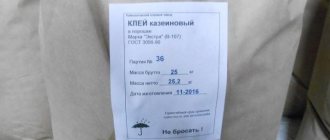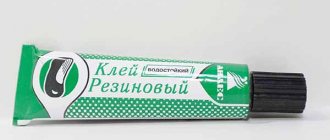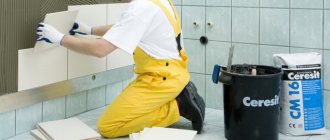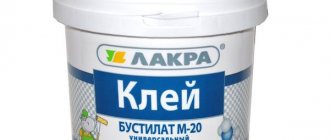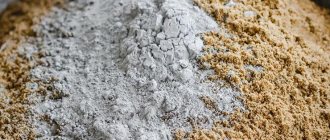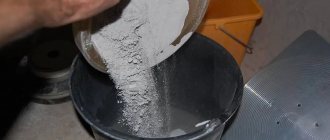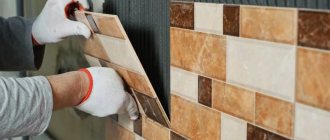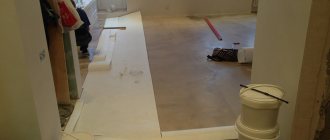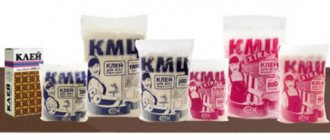People learned to mix PVA glue with cement mortar quite a long time ago. In this case, PVA glue is used to improve the quality of the solution. The material to which it is added becomes more plastic and quick-setting than a standard solution mixed with water.
Therefore, if in the rooms where the solution is used there is no constant source of high humidity, and the ambient temperature does not drop below 7 degrees Celsius, construction experts recommend adding PVA glue to cement-sand mortars. This significantly improves adhesion and greatly facilitates the process of working with the material.
Features of application
- increases plasticity;
- reduces the hardness of the finished product by increasing bending strength;
- increases the adhesion of concrete mortar to the surface.
PVA office glue is not suitable for use in concrete mix.
Depending on the purpose of the mixture being prepared, the proportions of cement to polyvinyl acetate are determined. For example, screed and masonry require different properties of the mortar.
As a precaution, it is better to use the adhesive-cement composition for landscaping areas where the operating temperature will be above 7°C.
Properties of PVA glue
PVA glue is a sticky mass of a snow-white hue, the consistency of sour cream, without a strong odor. This mass is created on the basis of polyvinyl acetate emulsion.
Classification of adhesive composition by purpose:
- Office;
- Furniture products;
- Construction products.
Depending on the purpose, each type of glue contains its own additives. The adhesive is not waterproof, but can withstand low temperatures and is not toxic. From an environmental point of view it is absolutely safe.
The adhesive is not waterproof, but can withstand low temperatures and is not toxic.
What kind of PVA glue can be added to cement mortar?
You need to choose the right adhesive. This improves the quality of concrete.
It is not advisable to purchase the substance in small quantities. This will increase costs because a lot of adhesive needs to be prepared. If you plan to add PVA glue to the cement mortar, you should pay attention to large containers.
So, 1 kg of the mixture costs 80 rubles. You can purchase the material in plastic containers. It is convenient to work with him. If the substance is not completely used up, the container is closed with a lid until the next opportunity when the material may be useful.
Adding glue correctly - step-by-step instructions
Before connecting the components, you need to find out how much adhesive mixture is needed. It is difficult to determine the exact quantity. The calculation is made approximate, taking into account proportions. It must be remembered that PVA is susceptible to ultraviolet radiation.
At the same time, it begins to lose properties. However, immediately after connection with the cement-sand mortar, the characteristics of the adhesive change. At the same time, the composition becomes resistant to ultraviolet radiation.
Kawabanga! How to fill holes in a concrete wall
If you plan to prepare a cement-based plaster composition, you should follow the instructions:
- Take M400 cement and add sand to it. The recommended ratio of components is 1:3.
- The mixture is diluted with water until a creamy consistency is obtained.
- Add glue. For 10 liters of cement mixture, use no more than 70 g of PVA.
The adhesive composition is characterized by a fairly viscous consistency. When added to a cement mixture, it will be difficult to mix. For this reason, you need to first add a little water to the adhesive. It is necessary to obtain milk of low viscosity.
Can I use a different glue?
It is acceptable to consider products from different brands:
- Latexcol;
- Inter Plast AT.
Inter Plast AT plasticizer contains modified surfactants. Produced on a water basis. Thanks to this substance, cement consumption is significantly reduced. At the same time, the strength of the finished structure increases.
Why add PVA glue to the cement mixture?
Polyvinyl acetate is an adhesive emulsion previously diluted in water. PVA glue is used in the construction industry as an additive to cement mixtures to improve technical characteristics. Often such compositions are used in plastering and leveling work; they also have excellent adhesion to any surface.
Change of material when adding glue
The proportions and technology of addition are determined depending on the purpose of the application, but basically the glue is added already diluted with water. These types of solutions should not be used in rooms with high humidity, since the glue is capable of absorbing moisture, as a result of which the layer may collapse or crack.
Polyvinyl acetate emulsion is one of the types of polymers and is used as a plasticizer. It has virtually no pronounced odor or toxic substances, so that when moisture dries and evaporates, no dangerous compounds are released. As a rule, PVA is added no more than 10% of the total amount of the cement mixture; it provides the following positive qualities:
- Increased plasticity and viscosity.
- Increases bending strength characteristics after complete hardening.
- The design is capable of withstanding a tensile load of at least 1.3 kg/cm².
- Increases the adhesive properties of cement-based compositions, this depends on their purpose. To obtain high-quality tile adhesive, the amount can be 15-20% of the total volume.
- Simplifies the work and application of the solution to the base.
Polyvinyl acetate homopolymer emulsion cannot be used for finishing wet rooms exposed to hot steam. In this case, hydrolysis is accelerated, which promotes constant conversion to alcohol even in concrete. Thus, when plastering walls in bathrooms, baths, saunas, swimming pools, as well as areas exposed to a humid environment, PVA is not used.
Another disadvantage is the lack of control over the strength gain of the mixture, that is, during the process of application and drying there are no exact instructions on the hardening time. This is due to the fact that the setting of the polymer material occurs regardless of the hydration of the concrete.
Glue is added to the DSP only of a certain brand. Types such as wallpaper or stationery are not suitable due to their high starch content, and adhesive bases for wood have many unnecessary compounds and impurities that are not compatible with cement.
To make mortar, it is best to use an aqueous dispersion containing more than 55% polymer additives. It is produced in plastic containers weighing 1-30 kg with a shelf life of up to 6 months.
Proportions and cooking technology
Adding glue is done in two ways. In the first case, PVA is poured in diluted form: the emulsion is poured into a vessel with water and completely stirred until a transparent consistency is obtained. In the second option, it is used in an undiluted, concentrated state.
The ratio of CSP ingredients should be selected based on its purpose:
- If the glue is used in a diluted state, then the optimal amount is considered to be no more than 10%. That is, for 25 kg of cement, take 0.5 liters of PVA.
- To fill a concrete floor: 1 part binder, 2 sand, 3 small crushed stone, 0.2 glue and 0.05 alkali-resistant pigment. Water is poured in for proper mobility.
- When laying tiles, the emulsion should make up about 20% of the total volume. The proportions of cement and sand are 1:5, and the binder should be chosen as M400 or more. There may be little or no water at all. When tiling concrete or aerated concrete slabs, adding glue to the solution will eliminate the need to prepare notches.
- The proportions for restoring screeds are 1: 3: 0.5 cement, sand and emulsion, respectively. 4% epoxy resin is also poured in. Then the mixture will have excellent adhesion to old concrete.
- For plastering work, a cement solution and PVA glue are used in a ratio of 1:0.07. In this case, the composition should already be ready for use. It is recommended to add sand clean and sifted from debris in an optimal amount of 1:3.
It is not recommended to violate standard proportions for mixing concrete and CFRP, as this affects their strength, reliability and durability. In this case, the adhesive component is only an additive to increase plastic properties. Then it acts as a connecting part and intervenes in the mixture until the material is completely homogeneous.
Author: Valentin Tokarev
| Related articles: | |
| Ready-made finishing mixture based on cement Types of plaster mesh and instructions for their installation Methods for cleaning surfaces from cement mixture | |
How to properly add PVA to cement mortar. Proportions, rules and nuances, mixture recipes
Many people are interested in how much PVA is needed for concrete? There are no exact calculations, only approximate ones regarding the required proportions. The maximum permissible limit of adhesive agent in the composition is 20%.
For tiles you will need a ratio of 1 to 5 (adhesive mixture and cement), but for screed you will need 5-12% glue. The question remains, how much PVA to add to the plaster solution?
Properties of PVA
PVA is a viscous white or yellowish liquid with high adhesive properties.
PVA glues only hygroscopic surfaces. If the surface cannot be wetted with water, polyvinyl acetate will not stick to it.
The substance is non-toxic, fire- and explosion-proof; has a slight specific odor, so it can even be used for gluing surfaces in children's rooms.
The emulsion easily withstands several freeze-thaw cycles without losing its qualities.
PVA is easily diluted with water, but after drying it polymerizes and becomes resistant to moisture.
After polymerization, it does not become brittle, which distinguishes it from many other types of glue.
The following types of polyvinyl acetate emulsion are used in everyday life:
PVA stationery glue (PVA-K). For gluing paper and cardboard.
Kawabanga! Concrete varnish for interior and exterior work: types and applications
PVA wallpaper glue. For gluing wallpaper.
PVA-M. For paper work only. The difference between this type of glue is its pure white tint, as well as its tendency to delaminate (a transparent layer appears on top).
PVA-MB (universal). Allows you to glue almost any materials; used in construction for adding to mortars and treating surfaces.
Why is PVA added to concrete?
One of the uses of PVA is to add an emulsion to concrete mortar. Why is this being done?
Construction mortars based on mineral binders, which include cement mortars, have some disadvantages:
with high compressive strength – low tensile and bending strength;
low impact resistance;
low adhesion (adhesion) to other materials;
low resistance to abrasion and the formation of large amounts of dust during abrasion;
low elasticity and mobility of thick solutions.
To avoid or prevent these disadvantages, the use of polymer additives is required.
Polymers influence the physical and chemical processes of setting and hardening of the solution and change the structure of hardened concrete.
Plasticized PVA dispersion combines well with mineral binders without adding a stabilizer, so the method is available not only in professional, but also in amateur construction.
What PVA glue can be used as an additive in concrete? Is it possible to use another glue?
At first glance, all PVA glues are the same. They have a similar appearance, smell, properties. They can all glue. Why do their properties differ?
If the word “glue” is present on the package, it means that other components have been added to the PVA solution: starch in paper glue, carboxymethylcellulose in wood glue.
Only PVA-MB and PVA dispersion are suitable for adding to cement mortar.
When to add
Ready-made cement-adhesive mixtures are sold in stores. You can mix them yourself. This is a durable, but at the same time inexpensive composition. The use of PVA in cement mortars is required if you need to prepare tile or plaster adhesive, adhesive compound for screed, etc.
Tile adhesive
When mixing the mixture for laying tiles, proceed according to the instructions. This composition perfectly holds tiles and ceramic products.
If you mix the solution yourself, adhere to the following rules:
- Take a large container, preferably one that you won’t mind throwing away after work.
- Pour dry ingredients into container and mix thoroughly.
- Add glue (about 20% of the total mass of the mixture). The adhesive mass is introduced into a mixture of 1 part cement and 5 parts sand. These proportions of cement and PVA result in a highly adhesive composition suitable for fixing objects on vertical planes.
- To prepare a liquid substance, cement, adhesive mass and water are mixed.
- The finished tile adhesive is applied to the walls with a notched trowel.
- If the tiles are small, the cement mixture is applied only to the walls. When working with heavy products, the solution is spread on the walls and additionally on each tile.
- It is not recommended to use tile adhesive at temperatures between +5°C and -30°C. Ideal conditions: temperature +20°C and air humidity not higher than 60%. With such indicators, the glue sets instantly.
- After application, allow the solution to dry for half a day.
- A composition containing PVA glue and cement holds the tiles for up to 20 years, provided that 1 part of cement, 4 parts of quarry sand and 1/20 of the total volume of glue are used.
- The quality of the mixture will improve if, before mixing in the glue, you first dilute it with water (one part water to two parts glue).
You can add PVA glue to the cement mortar for laying tiles in the following ratio:
- 1 liter of cement;
- 0.75 l of clean water;
- 0.25 l PVA;
All this is adjusted to the required consistency, depending on the specific situation.
Plaster
A plaster solution containing PVA glue is a popular means for high-quality finishing of ceilings and walls, as it slowly absorbs moisture. The cement composition dries slowly, which allows craftsmen to work more carefully with surfaces. In plaster glue, about 150 ml of PVA is enough for a volume of 10 liters.
Experts assure that even one tablespoon of PVA significantly increases the properties of plaster . The structure acquires increased plasticity, and the appearance of the composition also changes.
Screed
PVA cement is used not only for laying a new screed, but also for repairing the old coating. Craftsmen claim that fresh concrete does not adhere to old concrete, but when PVA glue is added, the fresh screed adheres to the old mixture without any hassle.
How to add:
- Mix 100 kg of Portland cement with 200 kg of quarry sand.
- Add 5-10 kg of alkali-resistant ingredients.
- Add 20 kg of glue and mix well.
- To prepare a thinner solution, add water.
When purchasing a ready-made mixture for screed, it is important to pay attention to its type. There are adhesives for paper containing starch and for wood containing a high percentage of CMC. For the screed, polyvinyl acetate containing at least 50% polymers is used.
What properties does adding PVA to the solution give to concrete?
Let's consider what properties appear in cement mortars with the addition of PVA (polymer cement mortars):
The adhesive properties of solutions increase.
The polymer bonds that form strong and elastic bonds at the level of the molecular framework of the hardened mortar increase the tensile and bending strength of the finished concrete.
The modulus of elasticity of the polymer is 10 times lower than that of concrete; therefore, the polymer-cement mortar is more deformable, which means it will chip less under impact loads. The crack resistance of concrete also increases.
Polymer-cement solutions take longer to dry, which has a beneficial effect on the development of the initial (after 24 hours) and design (28 days) strength of the finished products.
Floors coated with polymer cement mortar are abrasion resistant. The use of PVA works against the formation of dust during abrasion.
Kawabanga! How to choose a putty for concrete
Cons of adding PVA
Despite the many benefits that adding PVA provides, this practice also has disadvantages:
Limitations in use (high polymerization rate).
PVA additives in concrete can reach 20%, while modern plasticizing additives work no less effectively, but do not require high concentrations.
Expert advice and recommendations:
Check the expiration date of the glue.
Before starting work, stir the PVA.
Do not work with PVA at ambient temperatures below +10°C.
Make sure to use PVA-MB or PVA dispersion.
Observe the proportions of addition
How to dilute cement mortar and how much PVA to add to it
Depending on the purpose and area of application of the cement-sand mortar, from 5 to 20% PVA glue can be added to it.
To install a cement floor screed, 5-12% of the volume of a mixture of cement, sand and small crushed stone in a ratio of 1:2:3 will be sufficient.
To add polyvinyl acetate glue or dispersion to a cement mortar for plastering, you must first mix the mortar itself in the following order:
PVA is added to concrete in the same sequence, only crushed stone is added to the mixture of sand and cement before adding water, and the addition of PVA glue is taken at the rate of 200 g per 10 liters of solution.
When mixing the mortar for laying tiles, you need to mix cement of a grade of at least M400 with sand in a ratio of 1:5, and, without adding water, pour in PVA glue in an amount of 20% of the volume of the cement-sand mixture.
You can purchase high-quality glue and PVA dispersion at a competitive price in Ukraine in ours.
Advantages of mixing PVA glue with cement mortar
PVA glue, consisting of several polymers, is a kind of plasticizer. Getting into the cement mortar, it transfers its viscous properties to it and changes its structure.
This is why PVA is added to cement:
- the plasticity of the composition increases;
- working with cement becomes easier;
- after the cement hardens, the products are more durable in bending;
- the adhesion of the cement mixture increases;
- cement is easier to apply to the surface;
- the solution is used as tile adhesive.
After mixing, PVA glue and cement form a mass that is practically odorless. When frozen, it does not release harmful substances into the atmosphere. The unfrozen mixture disintegrates in water.
The only limitation when cement and PVA are not combined is the formation of a solution for rooms exposed to high humidity. The composition is not used when working in saunas and baths due to the large amount of steam - this leads to hydrolysis of polyvinyl acetate.

